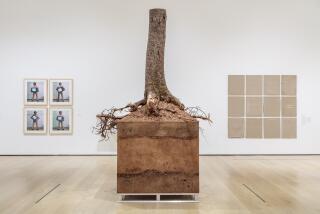Review: ‘Take It or Leave It’ reflects time of choice in the ‘80s
Remember the 1980s? Art museums are starting to. Now that a full generation has passed, curators have some historical distance on that time, when so much changed in American art and American life.
Last year, Chicago’s Museum of Contemporary Art did a savvy survey, “This Will Have Been: Art, Love & Politics in the 1980s.” The wide-ranging assembly of work, featuring 90 artists and several artists’ collectives, considered art through a lens of the era’s raucous social landscape.
Now, the UCLA Hammer Museum is looking at one specific facet of 1980s art. Or, to be more precise, it’s charting the intersection of two genres that together gained considerable traction then. The merger has been fruitful ever since.
PHOTOS: Faces to watch 2014 | Art
“Take It or Leave It: Institutions, Image, Ideology” does not have the most felicitous exhibition title. Unfortunately it hints at the turgid catalog that accompanies the show.
Never mind. The aim is clear, the show worthwhile.
One of the two genres that came together with force is appropriation art, born a century ago when Marcel Duchamp brought a plain old snow shovel into a gallery and proclaimed it “In Advance of the Broken Arm.” Appropriation simply changes the context for an object or image that already exists. A transformation occurs when a new context changes the way you see.
Felix Gonzalez-Torres did not make the 300 pounds of hard candies, each neatly wrapped in cellophane, that comprise his sculpture “Untitled” (USA Today). A faceless, unknown factory did.
But the artist’s decision to pile the red, silver and blue sweets on a museum floor, inviting visitors to take one as they contemplate the shiny all-American mound, denies a common assumption. Art is not created independently by an autonomous artist, the sculpture quietly insists; society shapes art’s meanings.
The other genre in the intersection that “Take It or Leave It” explores is art that is critical of established institutions, both social and artistic. Art has been critical of institutions at least since the Impressionists declared their brushy, paint-daubed canvases to be done, defying the sleek and carefully plotted finish that the powerful French Academy demanded of important art. Likewise, Gonzalez-Torres’ sculpture would be little more than eye-candy if it wasn’t rooted in a very deep institutional tradition.
ART: Can you guess the high price?
“Untitled” (USA Today) steals an established religious ritual: Take, eat; this is my body.
The institution of the Christian church has shaped many ideas about Western art — ideas we casually assume to be natural, even though they aren’t. Gonzalez-Torres, homosexual and raised Catholic in Cuba, came of artistic age when the ravages of the AIDS epidemic were not merely being ignored by many government institutions but were being exacerbated by religious prejudice. “Untitled” (USA Today) emphasizes art as a free-thinking, secular transaction.
For convenience, let’s give the show’s intersection of institutional critique and appropriation the nickname ICA art. “Take It or Leave It” does a good job of surveying the field.
With 118 ICA works by 36 artists, many represented by large-scale installations, the galleries are jam-packed. Sometimes it’s hard to tell where one work ends and another starts — say, Haim Steinbach’s Home Depot-style shelves of suburban backyard items (barbecue grills, clotheslines, firewood) and Cady Noland’s nearby convalescent-room walkers, arranged like a combative boxing ring. The chockablock exhibition design is more like a storage unit or grandma’s attic than a normal museum show, where individual works are given room to breathe.
The mash-up is surely intentional. For ICA art, a museum is an institutional context close to home, its traditions worth calling attention to through subversion.
Hammer senior curator Anne Ellegood and guest curator Johanna Burton have organized the galleries into loosely overlapping themes, such as the Media, Politics and the social space in which art and audience interact. Given the stuffed installation, that interaction is occasionally difficult, as when leaking video sound from one work interrupts focus on another.
Elsewhere it can enhance things. The engaging 1989 performance video of Andrea Fraser portraying a museum docent who gives a wacky, eye-opening exhibition tour echoes through multiple rooms. Daniel Patrick Moynihan’s controversial social theory of poverty isn’t often encountered during typical docent tours.
The 1980s is the show’s focus, but there’s no pretense that art evolves in neat calendar slots. In fact, feminist art of the 1970s is reasonably advanced as a prime foundation on which much ICA art was built.
The soiled baby clothing carefully framed in Mary Kelly’s 1973 “Post-Partum Document: Introduction” is the show’s earliest piece. Made when museums were busily promoting abstract stain-painting as the best new art, these appropriated, re-contextualized bibs from mommy’s nursery turned on its head the narrow claim for stained cloth as the greatest art.
Nor do artists just change course when a new decade arrives. Barbara Kruger was commissioned to make a new work for the lobby’s grand staircase, and she has been using graphic design techniques to collage found images and texts, often on an environmental scale, for 35 years.
Kruger’s smashing, slam-bam installation incorporates the illusion of a crystal ball distorting the text. One of the best parts is tucked away into an unobtrusive corner. Chunky white letters climbing a black wall declare, “Know nothing.”
PHOTOS: The most fascinating arts stories of 2013
As slang for a fool, the phrase condemns. As an instruction for being skeptical of certainties, it liberates. Welcome to the art museum.
A show that is critical of institutionalized formats and aesthetic beliefs won’t have many paintings, because no medium is more established. Allan McCollum’s cheeky “Plaster Surrogates” form a sculptural profusion of blank, molded, painting-like rectangles on the wall, which seems as if it could go on into infinity — a spiritual eternity.
The show’s few actual examples of paint on canvas tend to be rather wan. The most persuasive exception is Sue Williams’ big, pale-yellow “Scooter,” from 1992. It uses Willem de Kooning’s patented whiplash-line for an orgiastic celebration of feminine eroticism.
De Kooning’s ferocious “Woman” paintings had helped give birth to postwar American art, all while invoking conventional fears of the feminine. Williams pays homage, but she deftly replaces male dread with her own fierce and joyful abandon.
If there’s an important aspect to the origins of ‘80s ICA art that the show essentially overlooks, it might be guessed from the checklist of chosen artists. Three-quarters of them are (or were) based in New York. That might be an accurate reading of where the ICA efflorescence happened, but feminist roots don’t explain it.
CRITICS’ PICKS: What to watch, where to go, what to eat
What does is the simple fact that New York was then winding down a 30-year run as dominant crucible of profound new art. The most institutionalized art-city in the world, its metastasizing marketplace and ever-more tourist-oriented museums both took huge leaps in the 1980s.
The end was nigh, and artists responded. Devaluing institutional authority, including the authority of art museums and markets, was a frank acknowledgment that artists can’t and don’t work outside society’s frameworks. Appropriation of existing images and objects was one way to pull the plug on the significance historically placed on newness.
Take it or leave it, one might say. The Hammer show offers a lot to consider.
UCLA Hammer Museum, 10899 Wilshire Blvd., Westwood, (310) 443-7000, to May 18. Closed Monday. https://www.hammer.ucla.eduhttps://hammer.ucla.edu/
christopher.knight@latimes.com
MORE
PHOTOS: Hollywood stars on stage
PHOTOS: Arts and culture in pictures
More to Read
The biggest entertainment stories
Get our big stories about Hollywood, film, television, music, arts, culture and more right in your inbox as soon as they publish.
You may occasionally receive promotional content from the Los Angeles Times.











